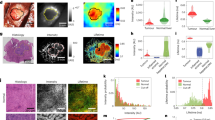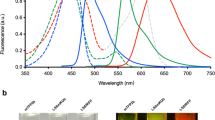Abstract
The intrinsic brightness of fluorescent proteins has been taken advantage of to develop a technology of whole-body imaging of tumors and gene expression in mouse internal organs. Stable transformation with fluorescent protein genes can be effected using retroviral vectors containing a selectable marker such as neomycin resistance. The cells that stably express fluorescent proteins can then be transplanted into appropriate mouse models. For whole-body imaging, nude mice are very appropriate. If wild-type mice are used, then hair must be removed by shaving or depilation. The instruments used can range from a simple LED flashlight and appropriate excitation and emission filters to sophisticated equipment such as the Olympus OV100 with a wide range of magnification, enabling both macroimaging and microimaging. It is crucial that proper filters be used such that background autofluorescence is minimal. Fluorescent protein–based imaging technology can be used for whole-body imaging of fluorescent cells on essentially all organs. The timeline for these experiments varies from 2 days to 2 months.
This is a preview of subscription content, access via your institution
Access options
Subscribe to this journal
Receive 12 print issues and online access
$259.00 per year
only $21.58 per issue
Buy this article
- Purchase on Springer Link
- Instant access to full article PDF
Prices may be subject to local taxes which are calculated during checkout









Similar content being viewed by others
References
Yang, M. et al. Whole-body optical imaging of green fluorescent protein-expressing tumors and metastases. Proc. Natl. Acad. Sci. USA 97, 1206–1211 (2000).
Yang, M. et al. Real-time whole-body imaging of an orthotopic metastatic prostate cancer model expressing red fluorescent protein. Prostate 62, 374–379 (2005).
Katz, M.H. et al. A novel red fluorescent protein orthotopic pancreatic cancer model for the preclinical evaluation of chemotherapeutics. J. Surg. Res. 113, 151–160 (2003).
Peyruchaud, O. et al. Early detection of bone metastases in a murine model using fluorescent human breast cancer cells: application to the use of the bisphosphonate zoledronic acid in the treatment of osteolytic lesions. J. Bone Miner. Res. 16, 2027–2034 (2001).
Hoffman, R.M. Green fluorescent protein imaging of tumor cells in mice. Lab Anim. 31, 34–41 (2002).
Hoffman, R.M. The multiple uses of fluorescent proteins to visualize cancer in vivo. Nature Rev. Cancer 5, 796–806 (2005).
Yang, M. et al. Whole-body and intravital optical imaging of angiogenesis in orthotopically implanted tumors. Proc. Natl. Acad. Sci. USA 98, 2616–2621 (2001).
Hemann, M.T. et al. Evasion of the p53 tumour surveillance network by tumour-derived MYC mutants. Nature 436, 807–811 (2005).
Mitsiades, C.S. et al. Fluorescence imaging of multiple myeloma cells in a clinically relevant SCID/NOD in vivo model: biologic and clinical implications. Cancer Res 63, 6689–6696 (2003).
Yang, M., Baranov, E., Moossa, A.R., Penman, S. & Hoffman, R.M. Visualizing gene expression by whole-body fluorescence imaging. Proc. Natl. Acad. Sci. USA 97, 12278–12282 (2000).
Panoskaltsis-Mortari, A. et al. In vivo imaging of graft-versus-host-disease in mice. Blood 103, 3590–3598 (2004).
Zhao, M. et al. Spatial-temporal imaging of bacterial infection and antibiotic response in intact animals. Proc. Natl. Acad. Sci. USA 98, 9814–9818 (2001).
Hoffman, R.M. & Yang, M. Subcellular imaging in the live mouse. Nat. Protocols 1, 775–782 (2006).
Heim, R., Cubitt, A.B. & Tsien, R.Y. Improved green fluorescence. Nature 373, 663–664 (1995).
Cormack, B., Valdivia, R. & Falkow, S. FACS-optimized mutants of the green fluorescent protein (GFP). Gene 173, 33–38 (1996).
Crameri, A., Whitehorn, E.A., Tate, E. & Stemmer, W.P.C. Improved green fluorescent protein by molecular evolution using DNA shuffling. Nature Biotechnol. 14, 315–319 (1996).
Delagrave, S., Hawtin, R.E., Silva, C.M., Yang, M.M. & Youvan, D.C. Red-shifted excitation mutants of the green fluorescent protein. Bio/technology 13, 151–154 (1995).
Zolotukhin, S., Potter, M., Hauswirth, W.W., Guy, J. & Muzyczka, N. A 'humanized' green fluorescent protein cDNA adapted for high-level expression in mammalian cells. J. Virol. 70, 4646–4654 (1996).
Martin, B.R., Giepmans, B.N., Adams, S.R. & Tsien, R.Y. Mammalian cell-based optimization of the biarsenical-binding tetracysteine motif for improved fluorescence and affinity. Nature Biotechnol. 23, 1308–1314 (2005).
Cody, C.W., Prasher, D.C., Westler, V.M., Prendergast, F.G. & Ward, W.W. Chemical structure of the hexapeptide chromophore of the Aequorea green fluorescent protein. Biochemistry 32, 1212–1218 (1993).
Ray, P., De, A., Min, J.-J., Tsien, R.Y. & Gambhir, S.S. Imaging tri-fusion multimodality reporter gene expression in living subjects. Cancer Res. 64, 1323–1330 (2004).
Burgos, J.S. et al. Time course of bioluminescent signal in orthotopic and heterotopic brain tumors in nude mice. Biotechniques 34, 1184–1188 (2003).
Yang, M. et al. Direct external imaging of nascent cancer, tumor progression, angiogenesis, and metastasis on internal organs in the fluorescent orthotopic model. Proc. Natl. Acad. Sci. USA 99, 3824–3829 (2002).
Schmitt, C.A. et al. Dissecting p53 tumor suppressor functions in vivo. Cancer Cell 1, 289–298 (2002).
Yang, M. et al. Dual-color fluorescence imaging distinguishes tumor cells from induced host angiogenic vessels and stromal cells. Proc. Natl. Acad. Sci. USA 100, 14259–14262 (2003).
Yamauchi, K. et al. Development of real-time subcellular dynamic multicolor imaging of cancer-cell trafficking in live mice with a variable-magnification small animal imaging system. Cancer Res. 66, 4208–4214 (2006).
Yang, M., Luiken, G., Baranov, E. & Hoffman, R.M. Facile whole-body imaging of internal fluorescent tumors in mice with an LED flashlight. BioTechniques 39, 170–172 (2005).
Hoffman, R.M. Green fluorescent protein imaging of tumour growth, metastasis, and angiogenesis in mouse models. Lancet Oncol. 3, 546–556 (2002).
Chishima, T. et al. Cancer invasion and micrometastasis visualized in live tissue by green fluorescent protein expression. Cancer Res. 57, 2042–2047 (1997).
Dusich, J.M., Oei, Y.A., Purchio, T. & Jenkins, D.E. In vivo detection of lung colonization and metastasis using luciferase-expressing human A549 lung cells. Proc. Am. Assoc. Cancer Res. 43, 1059 (2002).
Yamauchi, K. et al. Real-time in vivo dual-color imaging of intracapillary cancer cell and nucleus deformation and migration. Cancer Res. 65, 4246–4252 (2005).
Vooijs, M., Jonkers, J., Lyons, S. & Berns, A. Noninvasive imaging of spontaneous retinoblastoma pathway-dependent tumors in mice. Cancer Res. 62, 1862–1867 (2002).
Author information
Authors and Affiliations
Corresponding author
Ethics declarations
Competing interests
R.M.H. is the president of AntiCancer, which has commercial activities in the area of fluorescent protein–based imaging and has a Technology Development with Olympus.
Rights and permissions
About this article
Cite this article
Hoffman, R., Yang, M. Whole-body imaging with fluorescent proteins. Nat Protoc 1, 1429–1438 (2006). https://doi.org/10.1038/nprot.2006.223
Published:
Issue Date:
DOI: https://doi.org/10.1038/nprot.2006.223
This article is cited by
-
Practical Guidance for Developing Small-Molecule Optical Probes for In Vivo Imaging
Molecular Imaging and Biology (2023)
-
Modulating the distribution and fate of exogenously delivered MSCs to enhance therapeutic potential: knowns and unknowns
Intensive Care Medicine Experimental (2019)
-
In vivo long-term investigation of tumor bearing mKate2 by an in-house fluorescence molecular imaging system
BioMedical Engineering OnLine (2018)
-
Sensitive and non-invasive method for the in vivo analysis of membrane permeability in small animals
Laboratory Investigation (2017)
-
3′UTR polymorphisms of carbonic anhydrase IX determine the miR-34a targeting efficiency and prognosis of hepatocellular carcinoma
Scientific Reports (2017)
Comments
By submitting a comment you agree to abide by our Terms and Community Guidelines. If you find something abusive or that does not comply with our terms or guidelines please flag it as inappropriate.



